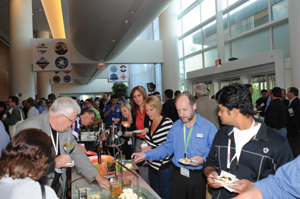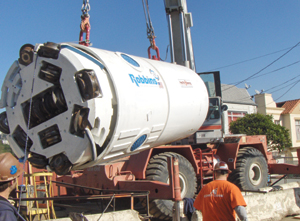Mortimer, the famed sewer rat, was offered up once again for the Education Auction at the No-Dig Show in Chicago. In a joint venture, Mortimer was purchased by Dan Liotti of Midwest Mole and Ray Post of Michels Corp. The joint venture brought the largest bid to date and gives Mortimer the chance to spend more travels across the country raising awareness for a great cause and offer more exposure to the education funding efforts.
 Mortimer spent the summer with Midwest Mole based out of Indianapolis. His first week on the job was not that of play but of hard work as he spent his days in Cincinnati, christening and launching the new TBM machine named “Jane” on Midwest Mole’s Shayler Run project that consists of 9,000 ft of 72-in. rock tunnel. He wasted no time popping the champagne bottle in celebration and jumping right in to work with “Jane.”
Mortimer spent the summer with Midwest Mole based out of Indianapolis. His first week on the job was not that of play but of hard work as he spent his days in Cincinnati, christening and launching the new TBM machine named “Jane” on Midwest Mole’s Shayler Run project that consists of 9,000 ft of 72-in. rock tunnel. He wasted no time popping the champagne bottle in celebration and jumping right in to work with “Jane.”
“Jane” is named after Jane Liotti, the late wife of Len Liotti, who founded Midwest Mole in 1982, and the mother of current company president Dan Liotti. Jane was instrumental in the success of the company in the early years by handling the office accounting and paperwork while Len Liotti developed and built the work. In 1987, Jane Liotti passed away of breast cancer.
Mortimer got his first taste of Hoosier hospitality by joining the company at the famous Indianapolis 500 race on May 30. Mortimer was to spend his spring/summer with Midwest Mole, and he will head to Wisconsin for the fall and winter. Michels Corp. will host Mortimer and his travels to finish out the year, so continue to be on the lookout for Mortimer, you never know where he will show up!
Read More
Category: News
NASTT Auction Raises a Record $52,000
The Ninth Annual Educational Fund Auction was held May 3 and raised a record-setting amount: $52,000. The auction raises financial support for NASTT’s 11 student chapters while attendees have a great time bidding on amazing items. Since 2002, the auction has raised more than $364,000.
 Ritchie Bros. Auctioneers once again served as the official auctioneers for the popular event. A silent auction was held as well. A wide range of items were donated for both events from jewelry and electronics to sporting event tickets and trenchless tools and equipment. Once again, Moritmer the Sewer Rat was up for bid and he will spend the next year with Midwest Mole and Michels Corp.
Ritchie Bros. Auctioneers once again served as the official auctioneers for the popular event. A silent auction was held as well. A wide range of items were donated for both events from jewelry and electronics to sporting event tickets and trenchless tools and equipment. Once again, Moritmer the Sewer Rat was up for bid and he will spend the next year with Midwest Mole and Michels Corp.
CLICK HERE FOR MORE PICTURES >>
Read More
Mortimer’s Final Akkerman Travels
 Mortimer’s been enjoying his remaining time with the folks at Akkerman. He recently went ice fishing for the first time at a local lake before our unseasonable warm up.
Mortimer’s been enjoying his remaining time with the folks at Akkerman. He recently went ice fishing for the first time at a local lake before our unseasonable warm up.
It’s a good thing that Mortimer knows his way around a deep sewer system. He visited Akkerman’s customer Lametti & Sons Inc. in Victoria, Minn., at the Victoria Interceptor Sewer Tunnels Project. He got to hang out with their crew and walk their 566-ft ring-beam and lagging tunnel, which spanned between a 90 ft launch shaft and 150-ft reception shaft.
In mid April he traveled to Daytona, Fla., to meet with area sales manager, Troy Stokes. Originally they intended to visit a jobsite, but it unfortunately experienced delays so Stokes figured: “‘Ol Morty could do with a bit of R&R instead.” He wrapped up his visit in Florida with excursions to the Daytona Speedway and Daytona Beach before his return to Minnesota.
As a final Minnesota hurrah, he hopes to attend a Twins game at the new Target Field to gnaw on some dome dogs.
In spring 2009, Akkerman purchased the traveling sewer rat from the 2009 International No-Dig Show’s North American Society for Trenchless Technology’s (NASTT) Education Auction. Mr. Rat originally hailed from the City of Reno, Nev., and first surfaced during the 2007 third annual Western Society for Trenchless Technology No-Dig Annual Conference. Glenn Boyce and the folks at Jacobs and Associates won him and he spent 2007 in Seattle. He then traveled to Grapevine, Texas, for No-Dig 2008, was purchased by Pacific Boring and spent the year in Caruthers, Calif.
Mortimer is ready for new adventures. He was offered up once again for the Education Auction at the No-Dig Show in Chicago, where he was bought by Dan Liotti, Midwest Mole, and Ray Post, Michels Corp. The Akkerman team truly enjoyed its time with Mortimer and wishes him the very best!
Read More
Midwest Mole Honored in Indiana
Midwest Mole Inc. recently announced that it has been ranked as one of the “Best Places to Work in Indiana” for the Small to Medium-size Companies (25 to 249 employees).
Companies setting the standard with their workplace practices were honored May 5, before a record-crowd at the Indiana Roof Ballroom as the Indiana Chamber unveiled rankings for the 70 companies from throughout the state that made the 2009 Best Places to Work in Indiana list.
The 2009 Best Places honors the top companies in the state, as determined through employer reports and comprehensive employee surveys. Winners were selected from two categories: small to medium-size companies that are between 25 and 249 employees, and large-size companies consisting of 250 or more employees. All companies that participated in the 2009 Best Places to Work program receive an in-depth evaluation identifying strengths and weaknesses, according to their employees. In turn, this report can be used in developing or enhancing employee retention and recruitment programs.
Midwest Mole Inc. is a specialist in trenchless technology doing business since 1982. For more information on Midwest Mole Inc., please visit the Web site at www.midwestmole.com.
Read More
Hard Rock Tackled in San Francisco Boring Project
California contractor Pacific Boring Inc. had a tough task on their hands. In less than 72 hours, the company needed to excavate the first 70 ft of a 300-ft long trenchless crossing underneath high-volume rail tracks. The trains — for the Bay Area Rapid Transit (BART) system — could only run on reduced speed for one weekend and steep penalties could be enforced if regular train operation was impacted.
 The crossing undercuts not only the rail line but also a 230-ft long section of Highway 280. Line and grade underneath the structures also needed to be accurate within 1 ft in predicted hard rock, requiring a boring machine rather than conventional auger boring machine (ABM) cutting heads. San Francisco Public Utilities Commission (SFPUC), in conjunction with Jacobs Associates, opted for a 60-in. diameter Robbins Motorized Small Boring Unit (SBU-M) for the job, which is a type of hard rock, trenchless boring attachment utilizing disc cutters.
The crossing undercuts not only the rail line but also a 230-ft long section of Highway 280. Line and grade underneath the structures also needed to be accurate within 1 ft in predicted hard rock, requiring a boring machine rather than conventional auger boring machine (ABM) cutting heads. San Francisco Public Utilities Commission (SFPUC), in conjunction with Jacobs Associates, opted for a 60-in. diameter Robbins Motorized Small Boring Unit (SBU-M) for the job, which is a type of hard rock, trenchless boring attachment utilizing disc cutters.
Project Overview
Located in southern San Francisco, the crossing is part of a 23,000-ft long, back-up cross town water main. The new line is the first of many for the SFPUC‘s East/West Transmission Project, which will build in redundancy in several key water lines in case of emergencies such as earthquakes or large scale pipeline failures. “This region is semi-arid and does not have readily available water supplies — all the supplies are actually groundwater piped in from the Hetch Hetchy reservoir located in the Yosemite National Park 300 miles away. The East/West project will help secure water supplies by piping in water from the eastern side of the city,” said Stephen Martin, construction inspector for the San Francisco Water Department. Once the pipeline is finished, the city’s two main reservoirs will be connected to one another.
“Most of this $4.56 billion project is allocated to pipelines. We have some smaller lines utilizing open-cut with jack and bores, but this is the most important pipeline we have in the city,” said SFPUC project manager Saed Toloui. At a cost of $23 million, the East/West pipeline will utilize one of San Francisco’s largest pumping stations and will undergo initial testing in May 2009.
SFPUC conducted geological testing including bore holes along the entire pipeline, as well as both conventional and horizontal bore holes for the Highway 280 crossing. Construction began on the pipeline in February 2007, requiring open-cutting of city streets by general contractor Ranger Pipelines Inc. As of February 2009, the entire pipeline had been open-cut and installed, minus the 300-ft crossing.
Choosing the Motorized SBU
Pacific Boring Inc., an auger boring and tunneling contractor from Caruthers, Calif., was subcontracted for the crossing and began site preparation in autumn 2008. The company had already completed two shorter bores using an ABM and conventional soft ground head for the project.
While Ranger Pipelines was excavating the 12-ft wide by 40-ft long launch pit for the BART tracks crossing, it hit much harder rock than anticipated (about 14,000 psi UCS). During pit excavation, the contractor also hit a mixed face of rock and soft ground at a 20-ft depth, prompting the crew to lower the boring pit another 20 ft into more stable rock.
The project team changed the initial contracted method, which specified pipe ramming. “After encountering the greywacke, which is very hard rock, we determined a larger diameter TBM or other methods would not be successful. We wanted a more versatile and accessible cutting head, and Pacific Boring suggested the SBU,” said Toloui.
“We had known about SBUs for a while and heard about them from other contractors that had used them, such as Midwest Mole. We were just waiting for the right project with the right geology,” said John Iles, vice president-operations of Pacific Boring.
The contractor also selected an SBU-M over other technologies, such as conventional auger boring. “We didn’t feel comfortable going 300 ft with augers taking all of the cutting torque,” said Iles.
The Robbins SBU-M is a manned entry, hard rock boring machine for use on long utility installations or for crossings with specific line and grade requirements. The SBU-M is utilized with a standard auger boring machine or pipe jacking unit and is mounted with disc cutters to excavate rock from 4,000 to more than 25,000 psi UCS. At machine launch, the SBU-M is welded to the lead casing and a small invert auger inside the casing provides spoil removal. An in-shield motor and drive train provides torque to the cutterhead, while forward thrust is provided by the ABM through the casing.
Crossing Excavation
The small construction site (40 ft wide by 80 ft long) on a residential street in the city was about 15 ft from a row of houses and prompted the contractor to move residents to a nearby hotel during the weekend launch of the SBU-M excavation began on a 24-hour basis on Jan. 31. Pacific Boring was given until Monday morning on Feb. 2 to make it past the 70-ft mark and the BART tracks.
 The machine, utilizing 11.5-in. disc cutters, began excavating the Franciscan formation consisting of greywacke rock. “After we got through the initial section of hard rock, we ran into a muddy fault zone for about 18 ft until we got back into the fractured rock we were expecting,” said Iles.
The machine, utilizing 11.5-in. disc cutters, began excavating the Franciscan formation consisting of greywacke rock. “After we got through the initial section of hard rock, we ran into a muddy fault zone for about 18 ft until we got back into the fractured rock we were expecting,” said Iles.
The fault zone, consisting of fractured rock and hard pan, allowed the machine to advance at a rate of about 1 ft every 30 minutes. Once back into hard rock, the machine averaged about 3 ft per hour. Every 20 ft, crews lowered a new section of 60-in. Permalok steel casing for installation. Muck was removed using a crane with hydraulic clam.
By Monday morning, the SBU-M had advanced about 80 ft, meeting the project goal. After the tight initial schedule, crews resumed normal 10-hr boring shifts. Pacific Boring expects to have the crossing completed in the first quarter of 2009.
Potential in Urban Spaces
The project highlights the urban use of SBU technology, which only requires the space of a standard auger boring pit and can be used close to residential structures without compromising foundations. “SBU technology definitely has potential for urban projects in California in the right type of rock,” said Iles.
“The pit size can be as small as 36 ft long by 10 ft wide for a 24-in. diameter SBU. At minimum, the contractor will need space for lifting equipment and spoil removal equipment, as well as support equipment such as welders and small tools,” said Chris Sivesind, SBU division sales engineer-West & Central U.S. Overall, the SBU-M/ABM or SBU-A/ABM setups need a larger shaft or pit than microtunneling or standard soft ground pipe jacking. However, the surface area required to support a microtunneling system is larger than either an SBU-M or SBU-A/ABM setup.
Distance to structures, such as houses or commercial buildings, depends on the ground conditions. In hard rock, the method of pit excavation is typically by drill-and-blast or rock hammer, which requires some distance to sink a shaft near a structure. The softer the ground, the less critical it becomes to maintain distance from structures due to common methods of ground stabilization such as secant piles. The amount of cover necessary also depends on the geology and pipe diameter, though most hard rock rail crossings require a minimum of 3 to 4 ft of cover.
People: Midwest Moles Announces Staffing

 Midwest Mole Inc. announced that Josh Cox has joined Midwest Mole as a project manager and estimator. He has more than six years experience in the construction industry and engineering combined.
Midwest Mole Inc. announced that Josh Cox has joined Midwest Mole as a project manager and estimator. He has more than six years experience in the construction industry and engineering combined.
Gary Gagliardi was also appointed to the position of safety director. Gagliardi has 15 years of safety experience in the areas of regulatory compliance, best practices, safety management and training. He is an authorized OSHA Outreach Instructor in Construction and General Industry.
Read More
